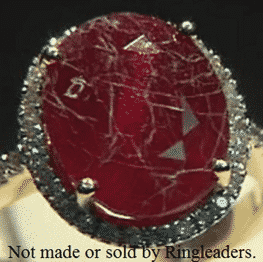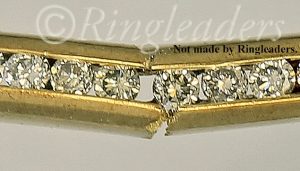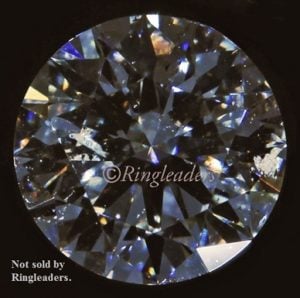Cheap gold and platinum is very common and a major problem, without warning these metals can fracture, causing break, cracks and claws or settings to fall off, etc. We’ve seen this in all types of Jewellery from cheap to expensive ($10,000+), and from all types of jewellers from designer to chain store, internet to bricks & mortar.
This channel set Diamond bangle was only a few years old when these 2 major failures happened.
Photo 1. Close up of crack, in the Channel setting (crack No.1), this can’t be repaired, as it will continue to crack. Top view.
Over 90% of “jewellers” are only resellers, (see- Fake jewellers, the factory made sold as local made rip off) and the easiest way to inspire confidence in customers is using deceptive/fraudulent claims about their qualifications, abilities and origins of their Jewellery (including custom made and stock). This problem is seen essentially in jewellery from factories in Asia, where most Jewellery is made today.
One more reason Ringleaders will not buy from factories.
Photo 2. Gold Bangle with 2 cracks from cheap faulty metal alloys (bangle only a few years old).
Carat* only refers to the percentage of gold in a piece of jewellery, but there are no laws regarding the other metals that make up the balance. By making Gold alloys with cheaper metals, (some are 500,000 x cheaper), you can increase profits, compete on price or both!
Cheap Gold and Platinum alloys can result in metal fatigue, a brittleness in the metal that can cause it fail with little to no warning, even big solid rings, chains, bracelets, etc. can crack and fall apart, (can also be caused by poor practices, e.g. over working metals).
Photo 3. Close up of crack on the hinge (crack No.2).
Not repairable.
This cannot be repaired as it will continue crack until it is remade with good metal and proper procedures. But as it can seem repaired when soldered together, we often meet people who have wasted money on 5-6 repairs, with an average of $1500 to $2000 (including replacing stones). But those “repairs” were only “patches” as they only appear fixed but it will continue to crack.
“Patches” are common as the majority jewelers with workshops have closed, many “jewelers” send repairs overseas factories, so the problem jewellery isn’t seen by a real jewelers and the patches just accumulate. Sadly I’ve met far too many people who were thinking of quote “just throwing my engagement ring in a draw and not wearing it”.
Photo 4. Close up of crack, in the Channel setting (crack No.1), Side view.
*(e.g. 18ct mean 18 parts per 24 should be gold, metric stamp for 18ct is 750, which means 750 parts per 1000 is gold).








